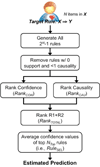Improving Personalized Clinical Risk Prediction Based on Causality-Based Association Rules
- PMID: 27532063
- PMCID: PMC4983415
- DOI: 10.1145/2808719.2808759
Improving Personalized Clinical Risk Prediction Based on Causality-Based Association Rules
Abstract
Developing clinical risk prediction models is one of the main tasks of healthcare data mining. Advanced data collection techniques in current Big Data era have created an emerging and urgent need for scalable, computer-based data mining methods. These methods can turn data into useful, personalized decision support knowledge in a flexible, cost-effective, and productive way. In our previous study, we developed a tool, called icuARM- II, that can generate personalized clinical risk prediction evidence using a temporal rule mining framework. However, the generation of final risk prediction possibility with icuARM-II still relied on human interpretation, which was subjective and, most of time, biased. In this study, we propose a new mechanism to improve icuARM-II's rule selection by including the concept of causal analysis. The generated risk prediction is quantitatively assessed using calibration statistics. To evaluate the performance of the new rule selection mechanism, we conducted a case study to predict short-term intensive care unit mortality based on personalized lab testing abnormalities. Our results demonstrated a better-calibrated ICU risk prediction using the new causality-base rule selection solution by comparing with conventional confidence-only rule selection methods.
Figures



Similar articles
-
icuARM-II: improving the reliability of personalized risk prediction in pediatric intensive care units.ACM BCB. 2014 Sep;2014:211-219. doi: 10.1145/2649387.2649440. ACM BCB. 2014. PMID: 27532061 Free PMC article.
-
icuARM-An ICU Clinical Decision Support System Using Association Rule Mining.IEEE J Transl Eng Health Med. 2013 Nov 21;1(1):122-31. doi: 10.1109/JTEHM.2013.2290113. eCollection 2013. IEEE J Transl Eng Health Med. 2013. PMID: 27170860 Free PMC article.
-
Early hospital mortality prediction of intensive care unit patients using an ensemble learning approach.Int J Med Inform. 2017 Dec;108:185-195. doi: 10.1016/j.ijmedinf.2017.10.002. Epub 2017 Oct 5. Int J Med Inform. 2017. PMID: 29132626
-
Data-driven modeling and prediction of blood glucose dynamics: Machine learning applications in type 1 diabetes.Artif Intell Med. 2019 Jul;98:109-134. doi: 10.1016/j.artmed.2019.07.007. Epub 2019 Jul 26. Artif Intell Med. 2019. PMID: 31383477 Review.
-
LEMRG: Decision Rule Generation Algorithm for Mining MicroRNA Expression Data.Adv Exp Med Biol. 2017;1028:105-137. doi: 10.1007/978-981-10-6041-0_7. Adv Exp Med Biol. 2017. PMID: 29058219 Review.
Cited by
-
Rule-Based Models for Risk Estimation and Analysis of In-hospital Mortality in Emergency and Critical Care.Front Med (Lausanne). 2021 Nov 8;8:785711. doi: 10.3389/fmed.2021.785711. eCollection 2021. Front Med (Lausanne). 2021. PMID: 34820408 Free PMC article.
-
Incorporating repeated measurements into prediction models in the critical care setting: a framework, systematic review and meta-analysis.BMC Med Res Methodol. 2019 Oct 26;19(1):199. doi: 10.1186/s12874-019-0847-0. BMC Med Res Methodol. 2019. PMID: 31655567 Free PMC article.
References
-
- Cook NR. Use and misuse of the receiver operating characteristic curve in risk prediction. Circulation. 2007;115(7):928–935. - PubMed
-
- Cook NR. Statistical evaluation of prognostic versus diagnostic models: beyond the ROC curve. Clinical chemistry. 2008;54(1):17–23. - PubMed
-
- Sacchi L, Larizza C, Combi C, Bellazzi R. Data mining with temporal abstractions: learning rules from time series. Data Mining and Knowledge Discovery. 2007;15(2):217–247.
Grants and funding
LinkOut - more resources
Full Text Sources
Other Literature Sources
Miscellaneous
